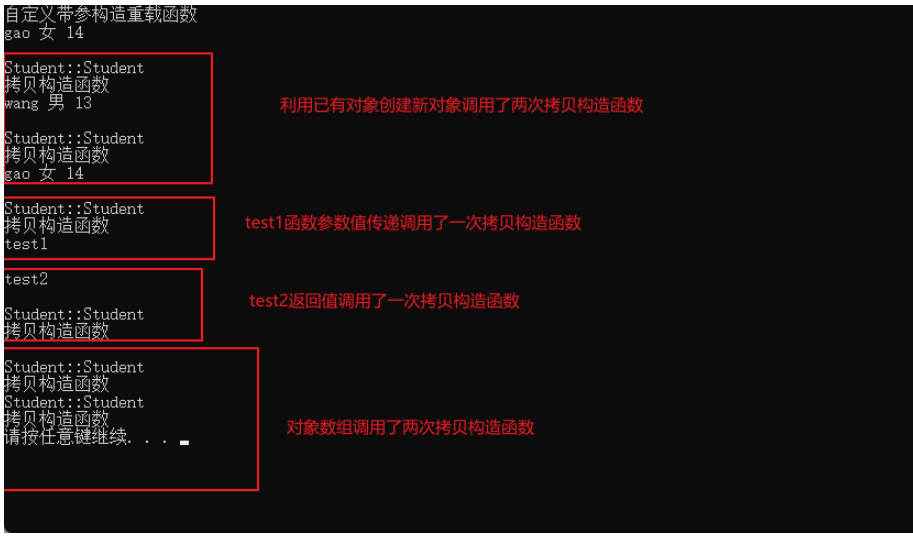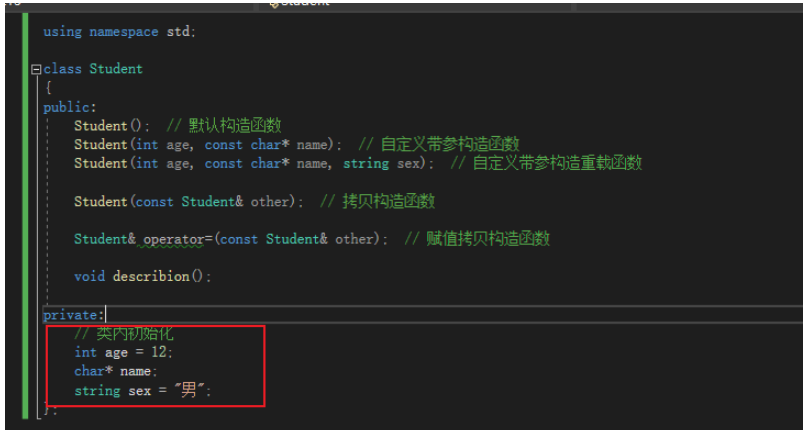C++面向对象中构造函数如何使用
这篇“C++面向对象中构造函数如何使用”文章的知识点大部分人都不太理解,所以小编给大家总结了以下内容,内容详细,步骤清晰,具有一定的借鉴价值,希望大家阅读完这篇文章能有所收获,下面我们一起来看看这篇“C++面向对象中构造函数如何使用”文章吧。
构造函数作用
构造函数可以在创建对象的时候初始化成员数据,或者利用现有对象修改现有对象数据(赋值拷贝构造函数)。
构造函数特征
自动调用,在创建对象的时候编译器自动调用 - 构造函数名和类名相同 - 构造函数没有返回值 - 可以有多个构造函数(类似函数重载)
构造函数种类
默认构造函数
自定义构造函数
拷贝构造函数
赋值构造函数
默认构造函数
编译器合成的默认构造函数
没有手动创建默认构造函数的时候,编译器会去自动合成构造函数
合成默认构造函数使用类内初始化数据去初始化数据
如果没有类内初始化数据,那么合成构造函数内就是空的什么都不做
默认构造函数
程序:
Student.h
#pragma once#include<iostream>#include<string>using namespace std;class Student{public:void describion();private:// 类内初始化// 创建对象的时候如果没有构造函数那边编译器会自己合成默认构造函数并且用这些数据来初始化对象// 编译器和合成的默认构造函数和手动定义的默认构造函数区别是:// 编译器合成的只会拿这些类内初始化数据去初始化对象// 手动定义的默认构造函数如果有初始化数据的时候也可以用其他数据去覆盖初始化数据,也就是说数据初始化的值以构造函数内为准int age = 12;char name[20] = "bian";string sex = "男";};Student.cpp
#include "Student.h"void Student::describion() {cout << this->name << " " << this->sex << " " << this->age << endl;}main.cpp
#include "Student.h"using namespace std;int main() {Student s1; // 创建对象调用默认构造函数s1.describion();system("pause");return 0;}结果:
bian 男 12
请按任意键继续. . .
手动定义的默认构造函数
手动定义的默认构造函数特点:Student::Student()
手动定义的默认构造函数和编译器和成的默认构造函数没太大区别。
唯一的区别:手动默认构造函数可以使用类内初始化的值,也可以不使用类内初始化的值。
程序:
Student.h
#pragma once#include<iostream>#include<string>using namespace std;class Student{public:Student();void describion();private:// 类内初始化int age = 12;char name[20] = "bian";string sex = "男";};Student.cpp
#include "Student.h"// 自定义默认构造函数Student::Student() {// 使用类内初始化数据来初始化// 其实这种就是编译器合成默认构造函数this->age = age;strcpy_s(this->name, 20, "bian");this->sex = sex; }void Student::describion() {cout << this->name << " " << this->sex << " " << this->age << endl;}main.cpp
#include "Student.h"using namespace std;int main() {Student s1; // 创建对象调用默认构造函数s1.describion();system("pause");return 0;}结果:
bian 男 12
请按任意键继续. . .
自定义带参数的构造函数
自定义带参数的构造函数特点:Student::Student(int age, const char name)*
带参数,可以重载。
代码:
Student.h
#pragma once#include<iostream>#include<string>using namespace std;class Student{public:Student(); // 默认构造函数Student(int age, const char* name); // 自定义带参构造函数Student(int age, const char* name, string sex); // 自定义带参构造重载函数void describion();private:// 类内初始化int age = 12;char name[20] = "bian";string sex = "男";};Student.cpp
#include "Student.h"// 自定义默认构造函数Student::Student() {// 使用类内初始化数据来初始化// 其实这种就是编译器合成默认构造函数cout << __FUNCTION__ << endl;cout << "自定义默认构造函数" << endl;this->age = age;strcpy_s(this->name, 20, "bian");this->sex = "未知";}// 自定义带参构造函数Student::Student(int age, const char* name) {cout << __FUNCTION__ << endl;cout << "自定义带参构造函数" << endl;this->age = age;strcpy_s(this->name, 20, name);}// 自定义带参构造重载函数Student::Student(int age, const char* name, string sex) {cout << __FUNCTION__ << endl;cout << "自定义带参构造重载函数" << endl;this->age = age;strcpy_s(this->name, 20, name);this->sex = sex;}void Student::describion() {cout << this->name << " " << this->sex << " " << this->age << endl;cout << endl;}main.cpp
#include "Student.h"using namespace std;int main() {Student s1; // 调用自定义默认构造函数s1.describion();Student s2(13, "wang"); // 调用自定义带参构造函数s2.describion();Student s3(14, "gao", "女"); // 调用自定义带参构造函数(重载)s3.describion();system("pause");return 0;}结果:
Student::Student
自定义默认构造函数
bian 未知 12Student::Student
自定义带参构造函数
wang 男 13Student::Student
自定义带参构造重载函数
gao 女 14请按任意键继续. . .
为什么会出现 wang 男 13,可以思考下这个男。答案在标题下方。
拷贝构造函数
拷贝构造函数特点:Student::Student(const Student& other)
深浅拷贝是针对在堆区开辟内存的数据,深拷贝重新开辟内存存数据,浅拷贝直接把原来的堆区拿过来用
合成拷贝构造函数
合成拷贝构造函数是编译器自动合成的属于浅拷贝
自定义拷贝构造函数
自定义拷贝构造函数可以实现深拷贝
Student.h
#pragma once#include<iostream>#include<string>using namespace std;class Student{public:Student(); // 默认构造函数Student(int age, const char* name); // 自定义带参构造函数Student(int age, const char* name, string sex); // 自定义带参构造重载函数Student(const Student& other); // 拷贝构造函数void describion();private:// 类内初始化int age = 12;char* name;string sex = "男";};Student.cpp
#include "Student.h"// 自定义默认构造函数Student::Student() {// 使用类内初始化数据来初始化// 其实这种就是编译器合成默认构造函数cout << __FUNCTION__ << endl;cout << "自定义默认构造函数" << endl;this->age = age;this->name = new char[20];strcpy_s(this->name, 20, "bian");this->sex = "未知";}// 自定义带参构造函数Student::Student(int age, const char* name) {cout << __FUNCTION__ << endl;cout << "自定义带参构造函数" << endl;this->age = age;this->name = new char[20];strcpy_s(this->name, 20, name);}// 自定义带参构造重载函数Student::Student(int age, const char* name, string sex) {cout << __FUNCTION__ << endl;cout << "自定义带参构造重载函数" << endl;this->age = age;this->name = new char[20];strcpy_s(this->name, 20, name);this->sex = sex;}// 拷贝构造函数Student::Student(const Student& other) {cout << __FUNCTION__ << endl;cout << "拷贝构造函数" << endl;// 浅拷贝,堆区地址还是以前的,其实编译器合成的拷贝构造函数就是这个this->age = other.age;this->name = other.name;this->sex = other.sex;// 深拷贝部分主要是堆区空间重新开辟this->age = other.age;// 重新开辟堆区this->name = new char[20];strcpy_s(this->name, 20, other.name);this->sex = other.sex;}void Student::describion() {cout << this->name << " " << this->sex << " " << this->age << endl;cout << endl;}main.cpp
#include "Student.h"using namespace std;// 拷贝构造函数调用第二种时机函数形参是值传递而不是引用void test1(Student other) {cout << __FUNCTION__ << endl;cout << endl;}// 拷贝构造函数调用第三种时机返回值是值传递Student test2(const Student& other) {cout << __FUNCTION__ << endl;cout << endl;return other;}int main() {Student s1; // 调用自定义默认构造函数s1.describion();Student s2(13, "wang"); // 调用自定义带参构造函数s2.describion();Student s3(14, "gao", "女"); // 调用自定义带参构造函数(重载)s3.describion();// 拷贝构造函数:调用时机1、利用已有对象创建新对象Student s4 = s2;s4.describion();Student s5(s3);s5.describion();// 拷贝构造函数:调用时机2、函数参数的值传递test1(s5);// 拷贝构造函数:调用时机3、函数返回值的值传递test2(s5);cout << endl;// 拷贝构造函数:代用时机4、数组值时对象Student s6[2] = { s1, s2 };system("pause");return 0;}结果:
Student::Student
自定义默认构造函数
bian 未知 12Student::Student
自定义带参构造函数
wang 男 13Student::Student
自定义带参构造重载函数
gao 女 14Student::Student
拷贝构造函数
wang 男 13Student::Student
拷贝构造函数
gao 女 14Student::Student
拷贝构造函数
test1test2
Student::Student
拷贝构造函数Student::Student
拷贝构造函数
Student::Student
拷贝构造函数
请按任意键继续. . .
结果解析:

拷贝构造函数的调用时间
程序演示已经在自定义拷贝构造函数中写了。
使用已有对象创建新对象
函数参数是对象值传递
函数返回值是对象值传递
数组成员是对象
赋值构造函数(operator=)
赋值构造函数特点:Student& operator=(const Student& other)
利用已有对象修改已有对象(f2 = f1;)
重载=运算符
程序:
Student.h
#pragma once#include<iostream>#include<string>using namespace std;class Student{public:Student(); // 默认构造函数Student(int age, const char* name); // 自定义带参构造函数Student(int age, const char* name, string sex); // 自定义带参构造重载函数Student(const Student& other); // 拷贝构造函数Student& operator=(const Student& other); // 赋值拷贝构造函数void describion();private:// 类内初始化int age = 12;char* name;string sex = "男";};Student.cpp
#include "Student.h"// 自定义默认构造函数Student::Student() {// 使用类内初始化数据来初始化// 其实这种就是编译器合成默认构造函数cout << __FUNCTION__ << endl;cout << "自定义默认构造函数" << endl;this->age = age;this->name = new char[20];strcpy_s(this->name, 20, "bian");this->sex = "未知";}// 自定义带参构造函数Student::Student(int age, const char* name) {cout << __FUNCTION__ << endl;cout << "自定义带参构造函数" << endl;this->age = age;this->name = new char[20];strcpy_s(this->name, 20, name);}// 自定义带参构造重载函数Student::Student(int age, const char* name, string sex) {cout << __FUNCTION__ << endl;cout << "自定义带参构造重载函数" << endl;this->age = age;this->name = new char[20];strcpy_s(this->name, 20, name);this->sex = sex;}// 拷贝构造函数Student::Student(const Student& other) {cout << __FUNCTION__ << endl;cout << "拷贝构造函数" << endl;// 浅拷贝,堆区地址还是以前的//this->age = other.age;//this->name = other.name;//this->sex = other.sex;// 深拷贝部分主要是堆区空间重新开辟this->age = other.age;// 重新开辟堆区this->name = new char[20];strcpy_s(this->name, 20, other.name);this->sex = other.sex;}// 赋值拷贝构造函数Student& Student::operator=(const Student& other) {cout << __FUNCTION__ << endl;cout << "赋值拷贝构造函数" << endl;if (this == &other) {return *this; // 防止出现f1=f1}// 浅拷贝,堆区地址还是以前的//this->age = other.age;//this->name = other.name;//this->sex = other.sex;// 深拷贝部分主要是堆区空间重新开辟this->age = other.age;// 重新开辟堆区this->name = new char[20];strcpy_s(this->name, 20, other.name);this->sex = other.sex;return *this;}void Student::describion() {cout << this->name << " " << this->sex << " " << this->age << endl;cout << endl;}main.cpp
#include "Student.h"using namespace std;int main() {Student s1(14, "gao", "女"); // 调用自定义带参构造函数(重载)s1.describion();// 调用赋值拷贝构造函数Student s2;s2.describion();s2 = s1; s2.describion();system("pause");return 0;}结果:
Student::Student
自定义带参构造重载函数
gao 女 14Student::Student
自定义默认构造函数
bian 未知 12Student::operator =
赋值拷贝构造函数
gao 女 14请按任意键继续. . .
特别注意
当存在类内初始值的时候,除了赋值拷贝构造函数外,其他的构造函数(默认构造函数、自定义参数构造函数、拷贝构造函数)在执行构造函数前都会先执行下数据初始值。

初始化列表只存在构造函数中(成员数据、父类对象可以使用初始化列表初始化)。
以上就是关于“C++面向对象中构造函数如何使用”这篇文章的内容,相信大家都有了一定的了解,希望小编分享的内容对大家有帮助,若想了解更多相关的知识内容,请关注编程网行业资讯频道。
免责声明:
① 本站未注明“稿件来源”的信息均来自网络整理。其文字、图片和音视频稿件的所属权归原作者所有。本站收集整理出于非商业性的教育和科研之目的,并不意味着本站赞同其观点或证实其内容的真实性。仅作为临时的测试数据,供内部测试之用。本站并未授权任何人以任何方式主动获取本站任何信息。
② 本站未注明“稿件来源”的临时测试数据将在测试完成后最终做删除处理。有问题或投稿请发送至: 邮箱/279061341@qq.com QQ/279061341

















